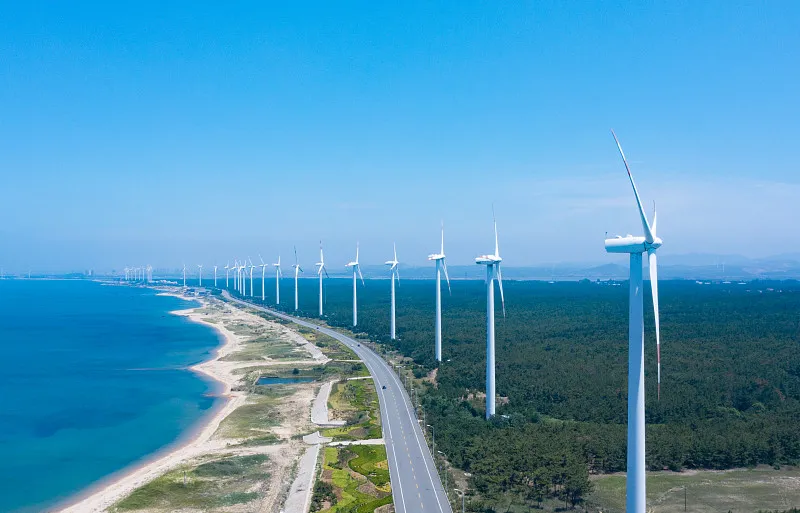Unlocking the Power of Offshore Wind: A Technological Marvel
Offshore wind power harnesses wind energy at sea, with offshore wind turbines central to this process. It offers advantages over onshore wind due to superior conditions: faster winds and stable rates of change. Small wind speed increases significantly amplify power output; a turbine at 15 mph generates double the electricity of one at 12 mph. Yet, challenges like rapid corrosion in the harsh marine environment persist for offshore wind power.
Characteristics and advantages of offshore wind power generation
Offshore wind power involves generating electricity in water depths around 10 meters, with offshore wind turbines leading this charge. Unlike onshore wind power, it doesn’t compete for land or face topographical limitations. The sea’s high wind speeds and abundant resources set offshore wind power apart. These turbines often have larger capacities, typically 3 to 5 MW, and operate more hours annually than onshore counterparts, boosting overall efficiency. Donghai Bridge Wind Farm, for instance, sees over 8,000 effective wind hours annually, with full load hours surpassing 2,600 post-installation—a 30% increase compared to onshore wind farms. However, offshore wind power’s construction technology is more complex, with costs averaging 2 to 3 times that of onshore wind power.
Current status and development of offshore wind power in China
As wind energy advances, onshore wind and solar reach limits, driving offshore wind in eastern China. Coastal regions hold vast wind resources, boosting clean energy initiatives. Four large offshore projects along China’s coast generate 19.3 billion kWh yearly. Despite a delayed start, China’s abundant resources and swift projects hint at global offshore wind leadership.

Technical challenges and solutions for offshore wind power
The accelerated advancement of offshore wind power underscores the enduring relevance of onshore wind power. China has consistently advocated for the concurrent development of onshore and offshore wind power, the harmonized advancement of centralized and decentralized wind power, and a strategy that amalgamates local power consumption with ultra-high-voltage long-distance transmission. Principal technical challenges confronting offshore wind power initiatives encompass wind turbine support technology and grid connection technology.
Wind turbine support technology
Offshore wind turbine support technology is bifurcated into bottom fixed support and suspended support systems. Bottom fixed support mechanisms encompass gravity caisson foundations, single pile foundations, and tripod foundations. In recent years, as global offshore wind power ventures venture into deeper and more remote seas, floating offshore wind power technology has emerged as a cutting-edge offshore wind power solution.
Bottom fixed support
The technology relies on caisson weight to anchor turbines. Caisson foundations are made of reinforced concrete, floated to the site, filled with gravel, and submerged. Their conical shape enhances resilience against ice floes in shallow seas (<10m). Monopiles are steel pipes driven into moderately deep waters. Tripod bases offer stability in deeper seas.
Suspended support
As offshore wind power ventures extend into remote seas, suspended support technology has surfaced as a viable solution. This approach is well-suited for regions characterized by substantial water depths, securing wind turbines on the sea surface via a floating structure, enhancing adaptability.
Grid connection technology
Grid connection technologies for offshore wind power encompass conventional AC transmission, low-frequency AC transmission, and flexible DC transmission. Offshore wind power grid connection encompasses two primary components:
- Offshore wind turbines link to offshore substations via 33 or 66kv submarine cables.
- Offshore substations interconnect with onshore substations via 132-220kv submarine photoelectric composite cables, culminating in power transmission to the grid company.
Distribution of offshore wind power projects in China
Regions along China’s eastern and southern coasts, such as Liaoning, Shandong, Jiangsu, Fujian, and Guangdong, are intensifying the construction of numerous expansive offshore wind power bases. These bases not only furnish clean energy for China but also constitute a vital avenue for achieving “carbon peak” and “carbon neutrality” objectives. The concentrated deployment of offshore wind power projects in Dalian, Liaoning, Dongying, Shandong, Nantong, Jiangsu, Zhoushan, Zhejiang, Shantou, Guangdong, and other locales has revitalized China’s coastline.
Future outlook
As a sustainable energy source, offshore wind power is assuming an increasingly pivotal role in China’s energy structure realignment. With ongoing technological progress and the gradual cost reduction, offshore wind power is poised to emerge as a cornerstone of China’s renewable energy landscape, making substantial contributions towards attaining sustainable development goals.
